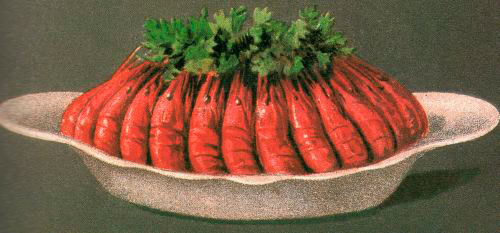Classic English Curried Shrimp from Locke-Ober
A dish of classic English curried shrimp made with a classic English curry sauce and served with baked curried rice was a mainstay of the menu at Locke Ober, the elegant and late lamented Boston institution that was hidden down a footpath off Winter Street by the Common. It is a mild simple curry prototypical of the Fannie Farmer flavor profile prevalent nationwide when the dish first emerged from the Locke Ober kitchen, but even so a composition with a twist. ‘Curried rice’ does not often accompany a curry and this one adds another dimension to the preparation. Our versions are based somewhat loosely on ones from Boston’s Locke-Ober Café by Ned and Pam Bradford.
For the sauce:
- 3 Tablespoons unsalted butter
- a peeled and chopped apple
- a chopped celery stalk or two
- a chopped onion
- 1 Tablespoon curry powder
 3 Tablespoons flour (preferably Wondra)
3 Tablespoons flour (preferably Wondra)- 2 cups hot chicken stock
- 2 oz light cream
- salt and pepper
For the curried rice:
- 1 Tablespoon unsalted butter
- a diced onion
- 1 cup rice
- 2 teaspoons curry powder
- 2 oz tomato sauce
- 2 cups chicken stock
- 1 teaspoon rice
For the curried shrimp:
- 4 Tablespoons unsalted butter
- about 1 lb raw peeled shrimp
- ½ cup Sherry (Fino or Amontillado depending on how dry you like your Sherry)
- Make the sauce by melting the 3 Tablespoons of butter over medium low heat in a heavy skillet.
- Add the apple, celery and onion until they just soften, reducing the heat if necessary to prevent the onion browning.
- Add the curry powder, stir it around for a couple of minutes, then stir in the flour until it loses its raw cast.
- Slowly stir the stock into the mix until the sauce is smooth and thick, usually in about five to ten minutes.
- Simmer the sauce, strain off the solids, then add the cream and seasonings.
- Increase the heat to high, add the cream, bring the sauce just to a boil and immediately remove the heat from the burner to prevent the cream curdling, whisking as you do.
- Keep the sauce warm.
Preheat the oven to 350°.
- Melt the Tablespoon of butter in a heavy ovenproof skillet that has a cover over medium low heat, then stir in the onion and cook it until clear.
- Add the rice, coat it with the onion butter, followed by the curry powder and tomato sauce, then the stock and salt.
- Stir the elements of the dish together, cover the skillet and bake the rice until dry and tender, usually in about 20-25 minutes.
- Keep the rice warm.
- Melt the 4 Tablespoons butter in a heavy skillet over high heat, flash the shrimp until they just curl and turn pink, then pour the Sherry over the shrimp and reduce it by half.
- Reduce the heat in turn to low, add about 1 cup of the curry sauce and simmer the shrimp for five minutes or so.
- Serve the shrimp with the rice along with a pitcher of the remaining curry sauce and, as the Bradfords demand, “with the usual curry condiments,” which they do not identify.
Notes:
-This is a preparation that screams for modification. Our version, for example, uses twice the amount of apple, celery and onion in the sauce from the original recipe, and if you like a textured curry you need not discard them at Step 5.
-You also might substitute coconut milk for the cream at Step 6. If you do, eliminate the flour at Step 3, cut the amount of stock in half and add 1½ cups at the end of Step 4, then fear no curdle and cook the sauce a little longer to marry the coconut.
-Cayenne added at Step 3 or the outset of Step 12 would neither do harm nor impair the authentically English pedigree of the dish.
-A shower of sliced scallion greens just before service enhances any curry from the cuisine of any culture, including this English one.

